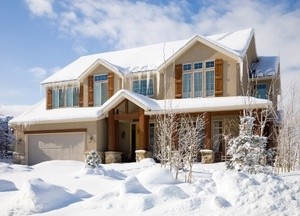
Tips For Winterizing Your Home
This page contains the following solutions.
Free home winterization and free lightbulbs: In many areas your power company may provide low income homeowners with a free winterization home inspection and certain power-saving fixes for the home. In other areas they may provide winterization kits for your windows free.
Here are the questions asked by community members. Read on to see the answers provided by the ThriftyFun community.
I forgot to winterize my garden hoses, they are still attached to the outside faucets of the house. It's been snowing and in the 20s for days now. What should I do? I'm afraid of my pipes freezing.
By Kathy from Wooster, OH

Take the hose off & drain them-
Many homes have an interior shutoff valve for exterior faucets; typically located on the interior wall of the house, directly behind the exterior faucet. The valve will either be a gate valve (round, wheel-shaped), or a ball valve (one with a lever).
Turn a gate valve clockwise to shut off the water supply to the outdoor water faucet; turn a ball valve a quarter turn. If the valve is difficult to turn, apply a lubricating spray, and then turn with an adjustable wrench.
A cold weather cover will provide extra protection. Try this: cut a hole in the center of the cover to an empty plastic butter or margarine tub, large enough to fit over the faucet. Place the lid over the faucet, the lid top should be against the house. Secure the lid to the house siding using screws or tacks.
Wrap a strip of fiberglass pipe insulation around the faucet, and secure with masking tape. Push the plastic tub over the faucet, and snap it onto the lid.
How to Install Insulating Tube on Interior Water Pipes
The quickest, easiest method of insulating exposed interior water pipes is to use insulating tube made for that purpose.
One great feature of this type insulation is that you do not need to remove it after winter. In fact, leaving the insulating tube on pipes year-round makes your home more energy efficient. It reduces energy used by the water heater to heat cold water. It also reduces noisy pipe sounds.
Interior pipe insulating tubes come in a variety of lengths, diameters, and materials. Therefore, measure length and diameter of pipes before purchasing tubes. Standard-sized residential pipes are &frac;-inch and &frac;-inch.
Insulating tubes are pre-slit down the center; simply place around the pipe, peel off the tape located on both edges, and stick them together as you work your way down the length of the tube.
Use a utility knife to cut the tube to fit the length of pipes, and duct tape to cover seams of connecting tubes. Caulk and/or weather strip around pipe entry points that travel through exterior walls.
good luck.
Excellent advise! Thank you very much! I especially like the butter tub idea!
I have mine covered and they froze solid but I have not had any pipes to burst.
I'm new to this, but was wondering if anyone had tips on winterizing an old house, i.e. windows, etc.?
By Jamerson
Okay, quick temporary way. Get Frost King Window covers. The thicker ones you can't see through but they work better than the see through heat to fit type. BTW the thick ones go outside on your window; they are nailed into the frame. The shrink to fit type are put on inside with double sided tape around the frame. For a really bad widow you could do both (I did).
Heating in general. If you have room for it get a wood stove or pellet stove. In some areas there are places where you can get wood for free, you just have to haul it. Either stove will greatly reduce your heat bill (electric, oil or propane). There are also newer stove designs to check into that I am unfamiliar with you can check out - Amish stove, for one. Good luck
You can buy various thicknesses of clear plastic on the bolt at Super Walmart Stores and is much cheaper than the kits.
Thermal insulated panels also help to keep rooms warmer in winter and cooler in summer. You can get a variety of window film patterns that also block out UV rays, add privacy and provide protection from some heat loss at Lowe's and Home Depot for about $30.00 and diy or have professionally done which is expensive.
You can buy weather stripping that works well around window frames and doors. Check for drafts around windows and doors and use caulking to help. (comes in clear and white) or use insulating spray foam in a can to help insulate and seal. Trim off excess evenly against wall/framework.
Are your walls/attic insulated? If they are not, this will make a huge difference in your heat bill. I know because we bought a huge house last year built in 1900. It had no insulation in the walls! None! There was some in the attic. Our first bill was around 450.00 for heat. We had our walls insulated by a professional and the very next heat bill was 220! That was during the beginning of our ice storm here in Illinois and is was cold, freezing cold for weeks. Hope this helps you too!
You really need to go around the house and make a list of all the problem areas. (We're in year three of ours and still fixing here and there!). Insulation should be first, then sealing drafts--check the bottom of doors, too, as you can buy sweeps that block the air flow. Plastic is good covering, as are thick drapes.
We have double hung windows that actually move in and out a little so we put wood blocks inside the sill, between the screen and window, to keep the inside window pushed in. You have to get creative.
Here's more:
www.thisoldworkshop.com/